Abstract
The intrinsic mechanisms of resistance to beta-lactam antibiotics in Serratia marcescens IFO 12648 were investigated, comparing the action of benzylpenicillin, apalcillin, cefazolin, and ceftizoxime. The minimal inhibitory concentrations for this strain were 1,600, 3.13, 6,400, and 0.05 microgram/ml, respectively. The addition of ethylenediaminetetraacetic acid markedly reduced the minimal inhibitory concentrations of benzylpenicillin and cefazolin, whereas those of apalcillin and ceftizoxime were not influenced. S. marcescens IFO 12648 produced only a low level of beta-lactamase activity constitutively, and the production was considerably increased by the addition of benzylpenicillin. Cefazolin was hydrolyzed rapidly by beta-lactamase activity, whereas benzylpenicillin, apalcillin, and ceftizoxime were poorly hydrolyzed. Peptidoglycan synthesis in ether-treated strain IFO 12646 cells was inhibited by a concentration of ceftizoxime markedly lower than that of cefazolin and by a concentration of apalcillin moderately lower than that of benzylpenicillin.
Full text
PDF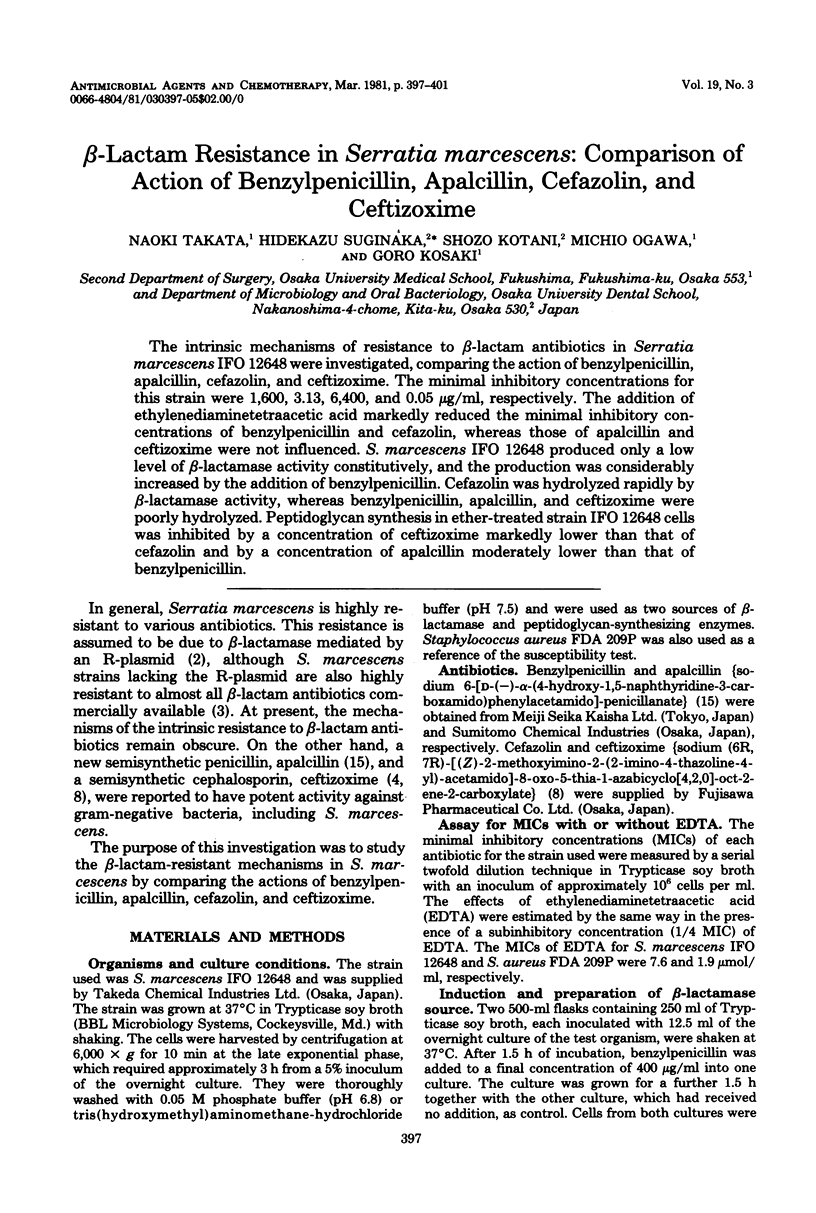
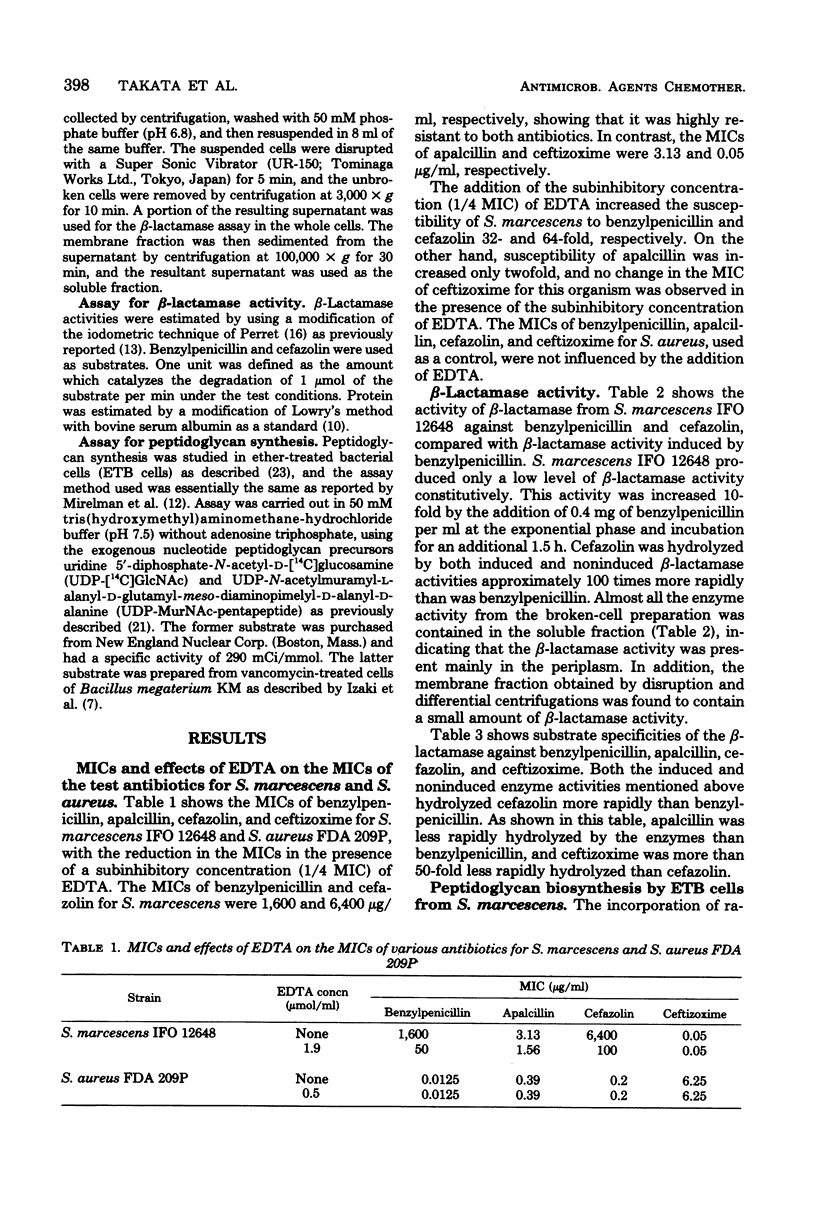
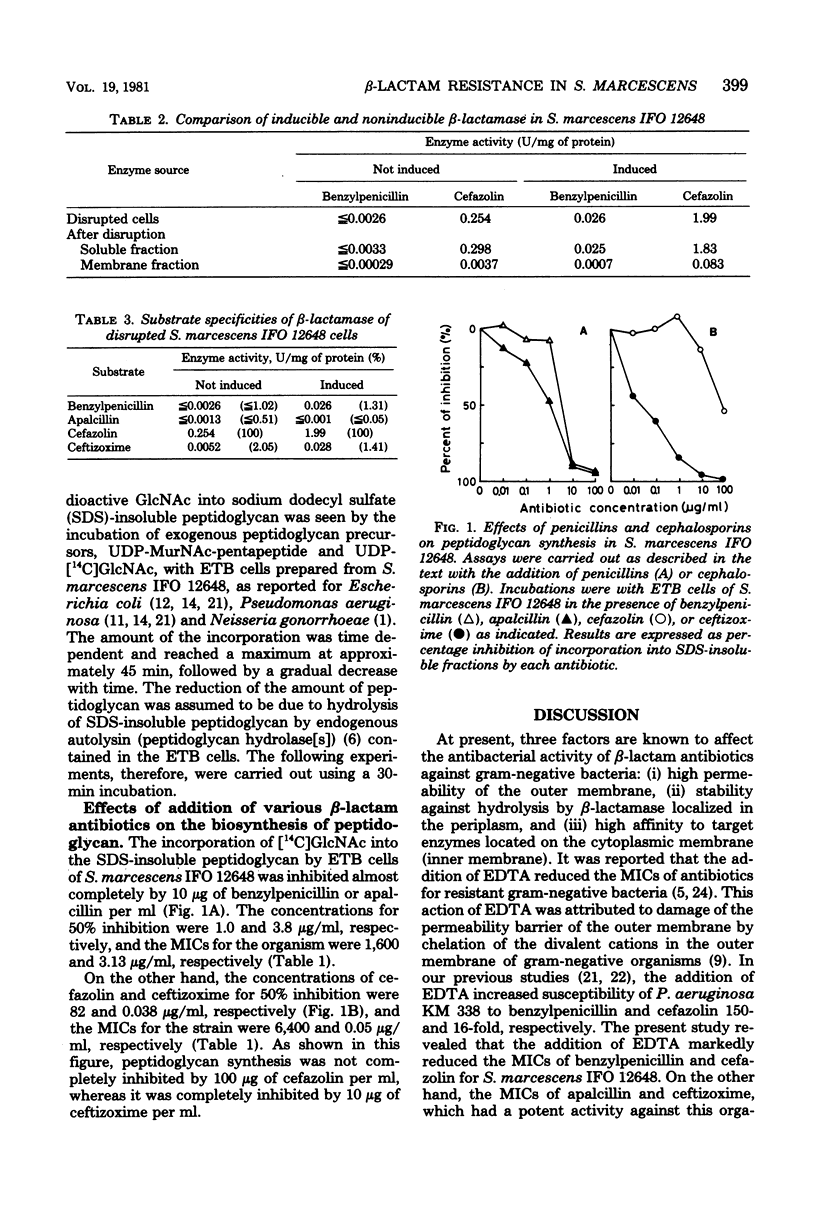
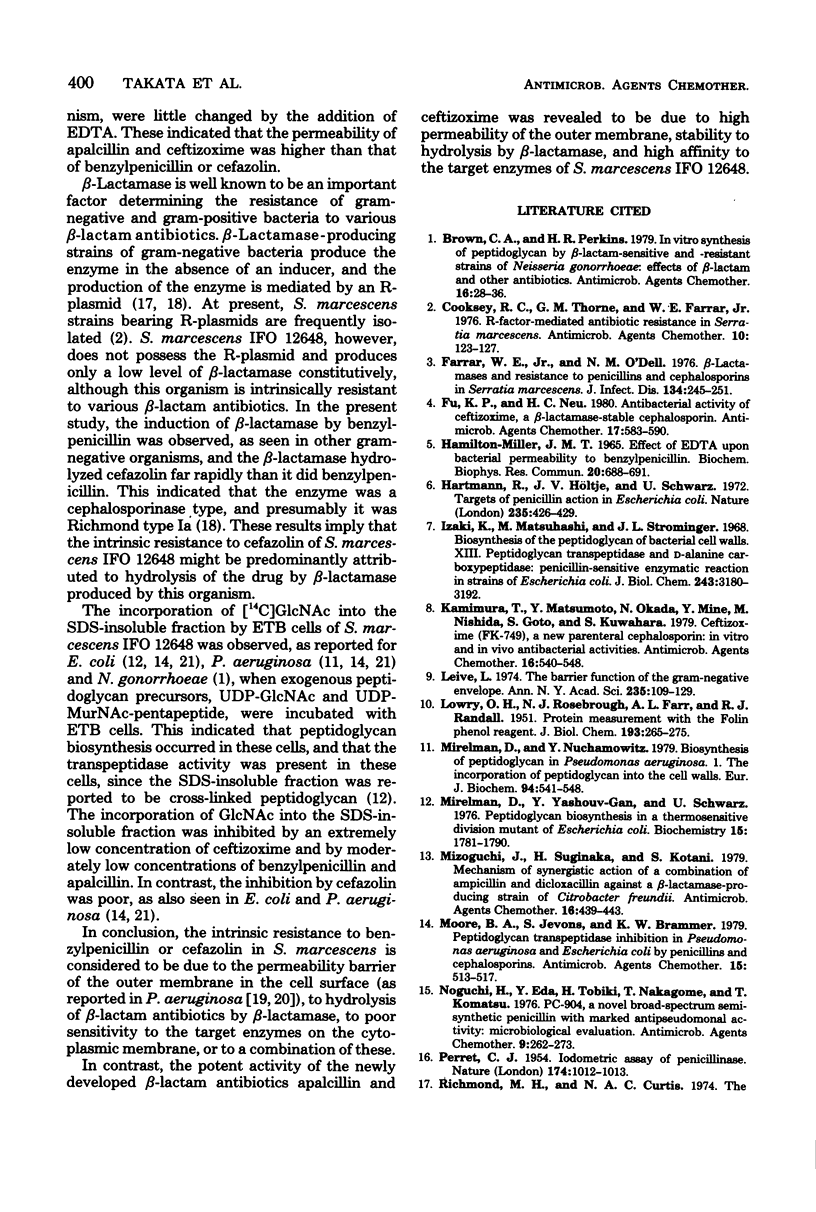
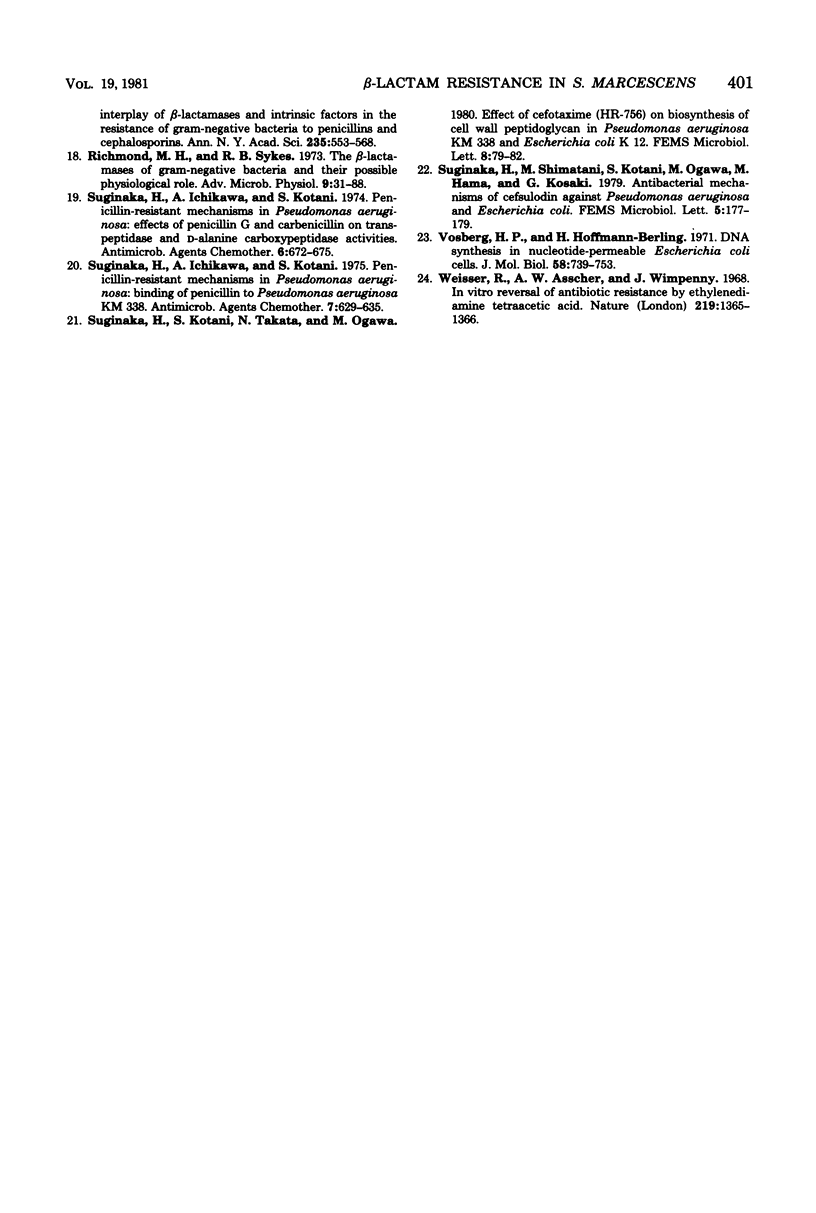
Selected References
These references are in PubMed. This may not be the complete list of references from this article.
- Brown C. A., Perkins H. R. In vitro synthesis of peptidoglycan by beta-lactam-sensitive and -resistant strains of Neisseria gonorrhoeae: effects of beta-lactam and other antibiotics. Antimicrob Agents Chemother. 1979 Jul;16(1):28–36. doi: 10.1128/aac.16.1.28. [DOI] [PMC free article] [PubMed] [Google Scholar]
- Cooksey R. C., Thorne G. M., Farrar W. E., Jr R factor-mediated antibiotic resistance in Serratia marcescens. Antimicrob Agents Chemother. 1976 Jul;10(1):123–127. doi: 10.1128/aac.10.1.123. [DOI] [PMC free article] [PubMed] [Google Scholar]
- Farrar W. E., Jr, O'dell N. M. beta-Lactamases and resistance to penicillins and cephalosporins in Serratia marcescens. J Infect Dis. 1976 Sep;134(3):245–251. doi: 10.1093/infdis/134.3.245. [DOI] [PubMed] [Google Scholar]
- Fu K. P., Neu H. C. Antibacterial activity of ceftizoxime, a beta-lactamase-stable cephalosporin. Antimicrob Agents Chemother. 1980 Apr;17(4):583–590. doi: 10.1128/aac.17.4.583. [DOI] [PMC free article] [PubMed] [Google Scholar]
- Hamilton-Miller J. M. Effect of EDTA upon bacterial permeability to benzylpenicillin. Biochem Biophys Res Commun. 1965 Sep 22;20(6):688–691. doi: 10.1016/0006-291x(65)90070-7. [DOI] [PubMed] [Google Scholar]
- Hartmann R., Höltje J. V., Schwarz U. Targets of penicillin action in Escherichia coli. Nature. 1972 Feb 25;235(5339):426–429. doi: 10.1038/235426a0. [DOI] [PubMed] [Google Scholar]
- Izaki K., Matsuhashi M., Strominger J. L. Biosynthesis of the peptidoglycan of bacterial cell walls. 8. Peptidoglycan transpeptidase and D-alanine carboxypeptidase: penicillin-sensitive enzymatic reaction in strains of Escherichia coli. J Biol Chem. 1968 Jun 10;243(11):3180–3192. [PubMed] [Google Scholar]
- Kamimura T., Matsumoto Y., Okada N., Mine Y., Nishida M., Goto S., Kuwahara S. Ceftizoxime (FK 749), a new parenteral cephalosporin: in vitro and in vivo antibacterial activities. Antimicrob Agents Chemother. 1979 Nov;16(5):540–548. doi: 10.1128/aac.16.5.540. [DOI] [PMC free article] [PubMed] [Google Scholar]
- LOWRY O. H., ROSEBROUGH N. J., FARR A. L., RANDALL R. J. Protein measurement with the Folin phenol reagent. J Biol Chem. 1951 Nov;193(1):265–275. [PubMed] [Google Scholar]
- Leive L. The barrier function of the gram-negative envelope. Ann N Y Acad Sci. 1974 May 10;235(0):109–129. doi: 10.1111/j.1749-6632.1974.tb43261.x. [DOI] [PubMed] [Google Scholar]
- Mirelman D., Nuchamowitz Y. Biosynthesis of peptidoglycan in Pseudomonas aeruginosa. 1. The incorporation of peptidoglycan into the cell wall. Eur J Biochem. 1979 Mar;94(2):541–548. doi: 10.1111/j.1432-1033.1979.tb12923.x. [DOI] [PubMed] [Google Scholar]
- Mirelman D., Yashouv-Gan Y., Schwarz U. Peptidoglycan biosynthesis in a thermosensitive division mutant of Escherichia coli. Biochemistry. 1976 May 4;15(9):1781–1790. doi: 10.1021/bi00654a001. [DOI] [PubMed] [Google Scholar]
- Mizoguchi J., Suginaka H., Kotani S. Mechanism of synergistic action of a combination of ampicillin and dicloxacillin against a beta-lactamase-producing strain of Citrobacter freundii. Antimicrob Agents Chemother. 1979 Oct;16(4):439–443. doi: 10.1128/aac.16.4.439. [DOI] [PMC free article] [PubMed] [Google Scholar]
- Moore B. A., Jevons S., Brammer K. W. Peptidoglycan transpeptidase inhibition in Pseudomonas aeruginosa and Escherichia coli by Penicillins and Cephalosporins. Antimicrob Agents Chemother. 1979 Apr;15(4):513–517. doi: 10.1128/aac.15.4.513. [DOI] [PMC free article] [PubMed] [Google Scholar]
- Noguchi H., Eda Y., Tobiki H., Nakagome T., Komatsu T. PC-904, a novel broad-spectrum semisynthetic penicillin with marked antipseudomonal activity: microbiological evaluation. Antimicrob Agents Chemother. 1976 Feb;9(2):262–273. doi: 10.1128/aac.9.2.262. [DOI] [PMC free article] [PubMed] [Google Scholar]
- PERRET C. J. Iodometric assay of penicillinase. Nature. 1954 Nov 27;174(4439):1012–1013. doi: 10.1038/1741012a0. [DOI] [PubMed] [Google Scholar]
- Richmond M. H., Curtis N. A. The interplay of beta-lactamases and intrinsic factors in the resistance of gram-negative bacteria to penicillins and cephalosporins. Ann N Y Acad Sci. 1974 May 10;235(0):553–568. doi: 10.1111/j.1749-6632.1974.tb43290.x. [DOI] [PubMed] [Google Scholar]
- Richmond M. H., Sykes R. B. The beta-lactamases of gram-negative bacteria and their possible physiological role. Adv Microb Physiol. 1973;9:31–88. doi: 10.1016/s0065-2911(08)60376-8. [DOI] [PubMed] [Google Scholar]
- Suginaka H., Ichikawa A., Kotani S. Penicillin-resistant mechanisms in Pseudomonas aeruginosa: binding of penicillin to Pseudomonas aeruginosa KM 338. Antimicrob Agents Chemother. 1975 May;7(5):629–635. doi: 10.1128/aac.7.5.629. [DOI] [PMC free article] [PubMed] [Google Scholar]
- Suginaka H., Ichikawa A., Kotani S. Penicillin-resistant mechanisms in Pseudomonas aeruginosa: effects of penicillin G and carbenicillin on transpeptidase and C -alanine carboxypeptidase activities. Antimicrob Agents Chemother. 1974 Dec;6(6):672–675. doi: 10.1128/aac.6.6.672. [DOI] [PMC free article] [PubMed] [Google Scholar]
- Vosberg H. P., Hoffmann-Berling H. DNA synthesis in nucleotide-permeable Escherichia coli cells. I. Preparation and properties of ether-treated cells. J Mol Biol. 1971 Jun 28;58(3):739–753. doi: 10.1016/0022-2836(71)90037-4. [DOI] [PubMed] [Google Scholar]
- Weiser R., Asscher A. W., Wimpenny J. In vitro reversal of antibiotic resistance by ethylenediamine tetraacetic acid. Nature. 1968 Sep 28;219(5161):1365–1366. doi: 10.1038/2191365a0. [DOI] [PubMed] [Google Scholar]


